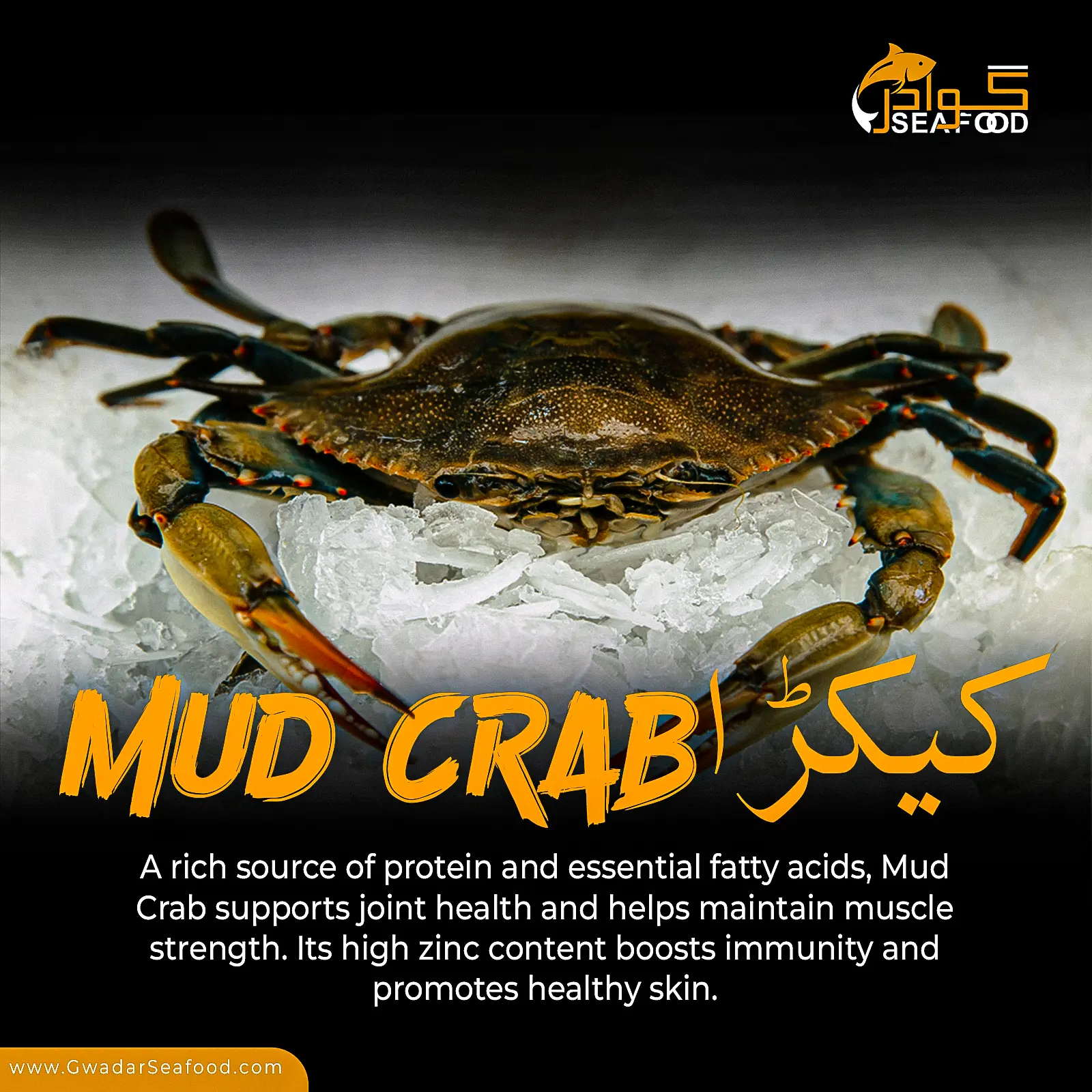Introduction
The Mud Crab, scientifically known as Scylla serrata, is a highly sought-after crustacean that thrives in the muddy, brackish waters of coastal regions. In Pakistan, it is commonly known as Kekra (کیکڑا). Mud Crabs are famous for their large, powerful claws and thick, robust exoskeleton. They are an important part of the local seafood market due to their sweet, tender meat and delicate flavor, making them a favorite in various culinary dishes. The meat of the Mud Crab is known for being rich and slightly sweet, offering a unique texture that contrasts beautifully with the tender legs and claws. The crabs are caught primarily from the coastal regions of Karachi, Balochistan, and other parts of the Arabian Sea.
Mud Crabs are versatile in cooking, whether for steaming, grilling, or adding to curries. Their striking appearance, with a dark green to brown carapace and large claws, makes them easy to recognize. However, despite their large size, the yield of meat per crab is relatively moderate, but the exceptional taste makes them a prized delicacy among seafood enthusiasts.
Deep Dive: Habitat, Diet & Growth
Habitat
Mud Crabs inhabit mangrove forests, mudflats, and estuaries, areas where the saltwater meets freshwater. These regions offer the crabs a mix of nutrients and shelter. The Mud Crab is primarily found in the intertidal zones, where it burrows into the soft, muddy or sandy substrate. This habitat allows the crabs to escape predators and thrive in nutrient-rich environments.
Mud Crabs can be found in shallow coastal waters, typically in depths ranging from 1 to 10 meters, although some can be found deeper in the water. Their presence is most prominent in the Arabian Sea, specifically around Karachi and the Balochistan coasts in Pakistan, where their numbers have been steadily increasing due to the favorable conditions for breeding and growth. These crabs are known for their burrowing habits, which play an essential role in the local ecosystem by promoting aeration in muddy environments.
Diet
As opportunistic feeders, Mud Crabs have a varied diet that includes mollusks, crustaceans, and small fish. They are known to scavenge as well, feeding on detritus and organic matter found in their habitats. The diet of a Mud Crab influences the flavor and texture of its meat, contributing to its rich taste profile. These crabs are particularly fond of benthic organisms and mollusks that dwell in the mud, making them essential in controlling the population of these species in their natural habitat. They are also known to consume smaller crabs, making them apex predators in their ecosystem. Their feeding behavior contributes to the balance of the coastal food web.
Mud Crabs feed primarily during the night, using their claws to forage for food and scavenge. Their ability to catch and crush their prey with their powerful claws allows them to consume a wide variety of marine organisms.
Growth
Mud Crabs exhibit significant growth during their early life stages, particularly in areas with abundant food supply. These crabs are fast-growing, especially when juveniles, and their growth rate depends largely on water quality and food availability. The crabs begin as larvae and undergo several molts (shedding of the exoskeleton) as they mature.
Typically, Mud Crabs reach a carapace width of around 15 cm in about 1 to 2 years, although some individuals can grow much larger, reaching up to 25 cm in carapace width. This rapid growth rate is facilitated by optimal conditions in their coastal environments, particularly in mangrove ecosystems, where abundant food sources are available.
Mud Crabs are also known for their ability to survive in fluctuating environmental conditions, including changes in salinity, temperature, and oxygen levels, making them highly adaptable.
Concise Addition: Spawning & Conservation
Mud Crabs spawn during the warmer months, typically in spring and summer, releasing millions of fertilized eggs into the water. These eggs then hatch into larvae, which eventually develop into juvenile crabs. The larvae go through several developmental stages before becoming fully grown adults.
Mud Crabs are a species with significant commercial importance, making them vulnerable to overfishing if not managed properly. Although the IUCN does not currently list the Mud Crab as endangered, conservation efforts are necessary to ensure sustainable populations. Protecting their natural habitats, particularly mangroves and estuarine ecosystems, is crucial for their continued survival. Sustainable harvesting practices, such as limiting the catch during the breeding season and implementing size limits, are important steps to help prevent overfishing and maintain healthy crab populations.
Names & Taxonomy
-
Common Name: Mud Crab
-
Local Name in Pakistan: Kekra (کیکڑا)
-
Scientific Name: Scylla serrata
-
Family: Portunidae
-
Order: Decapoda
-
Class: Malacostraca
Mud Crabs are part of the Portunidae family, which includes other species like the Blue Swimming Crab. They are recognized by their large, robust body and strong claws, which are ideal for grasping and crushing prey. The species Scylla serrata is particularly distinguished by its large carapace and powerful claws, which are used both for defense and hunting.
Sourcing & Catching Method
The Mud Crab is typically wild-caught using traditional methods such as trap fishing, gill nets, and tidal traps. Local fishermen use hand-lines, crab pots, and nets to catch these crabs, ensuring minimal harm to the surrounding environment. Once caught, the crabs are immediately processed and shipped to ensure they reach the market in peak condition. In some areas, aquaculture practices are also used to breed and raise Mud Crabs for commercial purposes, helping to meet growing demand.
Physical Traits & Texture
-
Shell Color: The Mud Crab’s shell is typically dark green to brown with rough patches and a mottled appearance.
-
Claws: They have large, powerful claws, often much larger than their body, with sharp pincers used to grab and crush their prey.
-
Texture: The meat is firm, sweet, and moist, with a distinctive taste that is less briny than other types of crabs. The claws and legs are the most prized for their rich, succulent meat.
-
Size: The Mud Crab can grow up to 25 cm in carapace width, making it one of the larger crab species
Cutting Options & Yields
| Option | Approx. Yield | Best For |
|---|---|---|
| Whole (uncleaned) | ~100% | Whole roasts, soups, and broths |
| Claws & Legs Removed | ~70% | Grilling, BBQ |
| Shell Removed | ~35% | Meat-only dishes, curries |
| Meat Only | ~15% | Stuffing, gourmet preparations |
Cooking Ideas – Versatile, Rich & Crowd-Friendly
-
Crab Karahi: This is a popular dish where Mud Crab is cooked with spicy green masala, tomato, and onion gravy for a rich, aromatic flavor.
-
Garlic Butter Crab: A simple yet flavorful preparation where Mud Crab is sautéed in butter, garlic, and a hint of lemon for a delicious dish.
-
Crab Malai: The crab meat is cooked in a creamy, rich coconut milk gravy, offering a smooth and spicy contrast to the sweet crab meat.
-
Crab Noodles: For an Asian twist, Mud Crabs can be stir-fried with soy sauce, chili, and noodles for a quick and tasty meal.
-
Crab Yakhni: A slow-cooked broth using crab and whole spices, served with rice for a comforting, traditional meal.
Tips for Selecting Fresh Mud Crab (Kekra)
-
Shell: The shell should be hard and intact with no cracks or deformities. A rough texture is a good indicator of freshness.
-
Eyes: Look for bright, clear eyes. Cloudy or sunken eyes may indicate that the crab is not fresh.
-
Smell: The crab should have a mild ocean smell, with no overpowering fishy odor. A fresh crab has a clean, seawater aroma.
-
Movement: Fresh crabs will be active and responsive to touch. If the crab appears lethargic, it may be a sign of poor quality.
Tips for Storing Mud Crab
-
Shell: The shell should be hard and intact with no cracks or deformities. A rough texture is a good indicator of freshness.
-
Eyes: Look for bright, clear eyes. Cloudy or sunken eyes may indicate that the crab is not fresh.
-
Smell: The crab should have a mild ocean smell, with no overpowering fishy odor. A fresh crab has a clean, seawater aroma.
-
Movement: Fresh crabs will be active and responsive to touch. If the crab appears lethargic, it may be a sign of poor quality.
Nutrition Highlights (per 100 g raw meat)
-
Protein: ~20–22 g
-
Fat: ~2–3 g
-
Carbohydrates: 0 g
-
Sodium: ~50-60 mg
-
Omega-3 Fatty Acids: ~0.5 g
-
Calories: ~100 kcal
-
Calcium: ~20-30 mg
-
Iron: ~1.0-1.2 mg
Need Something Similar?
-
Blue Swimming Crab: For a sweeter, more tender meat.
-
Three Spot Crab: Delicate flavor, perfect for soups.

 Sea Fish
Sea Fish
Abu Bakar Khan –
Bohoot achi quality thi or service bhi zabardast thi